Nikki Brighton – Old Kilgobbin
I do love ‘butterfly season’ in Dargle! My garden seems to be constantly on the move, with spots of colour flashing between Hypoestes, Kniphofia, Senecio, Polygala and Leonotis.
Things are a bit quieter in the hills. Has anyone else noticed that there are seldom jackal calling at night? I still hear owls, but no jackal. Have seen a few groups of reedbuck – about 8 in total, during my grassland walks and one bushbuck.

A couple of times I have come across Jackal Buzzards sitting quietly on hay bales waiting for a snack to show itself in the newly shorn fields. Unsure who this little brown fellow is in the tall grass?

I adore the subdued colours of this season. Lots of orange Leonotis leonaurus and the last of the Berkheya flowers

Most of the Gomphocarpus physocarpus pods have popped releasing their fairy seeds to float away.

The leaves of this Boophane have just abandoned the bulb.

Phymaspermum acerosum, still flowering, but faded.
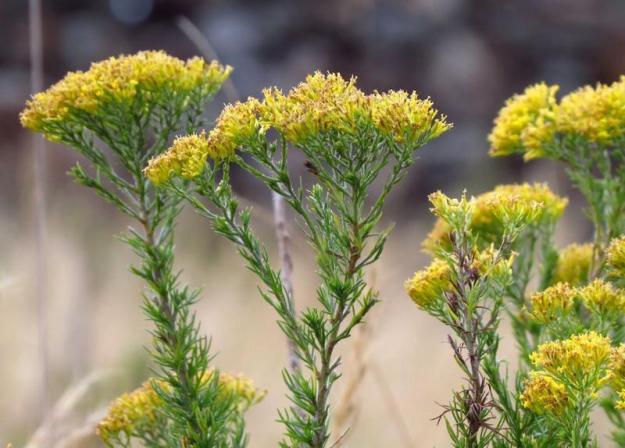
A solitary Aristea stands tall amongst the autumn golds.

Clutia cordata, the grassland clutia, which grows to about 70 cm tall. The plants are single sex. Tiny pale green male and female flowers on separate plants clustered along the stalks.

Loved this twirled grass – anyone know which variety it is?

Shadows in the very scarce pools of water are spectacular. How on earth are animals to survive this winter when the streams have already stopped trickling?

Michael Goddard – Steampunk Coffee
Not sure if these little guys have been spotted this far inland but this morning I saw this pair. Common myna (Acridotheres tristis), sometimes spelled mynah, also sometimes known as “Indian myna”

Jen Fly – Kildaragh Farm
At the beginning of the month we had Gurney’s Sugarbird in the garden revelling in the abundant blooms of the Leonotis. However they disappeared after a day or so. Probably off to the locally grown proteas, that they much prefer. A Greater Honeyguide was calling in the garden a couple of weeks ago. His unmistakable call of ” vic – tor ” rang out clearly, but I was unable to find him. Another uncommon sight for Kildaragh was a Purple Heron at our little dam. We have recorded one there before,but that was a few years ago. Below is the ribbon bush. Orthosiphon labiatus, a very worthwhile plant for the indigenous garden and the bees love it.
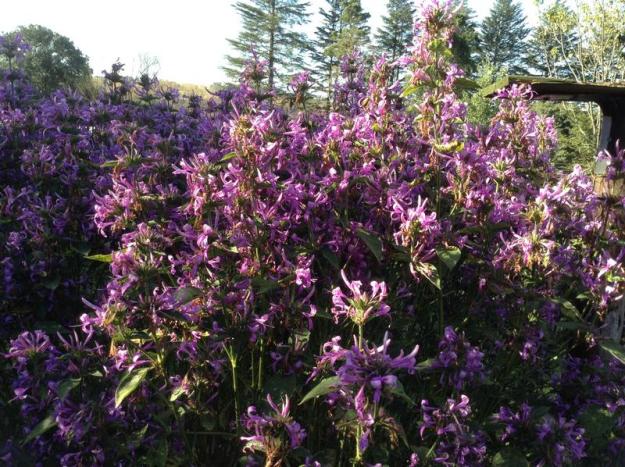
Can anyone out there help me with the identification of the plant below? I know it is African and that it is perhaps a Halleria elliptica (E. Cape), which grows to about 2m. However I am not convinced that it is…
Comment by Nikki Brighton: Looks exotic. Pretty sure it is not indigenous.
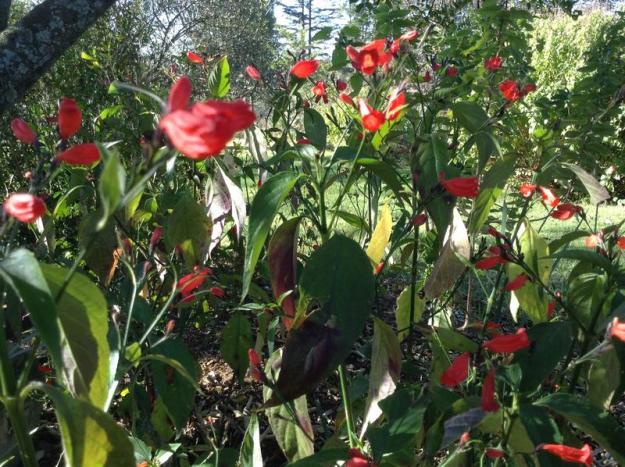
Andrew Pridgeon – Copperleigh Farm
Skaapsteker on the road


Nola Barrett – God’s Grace
I took this picture of this minute little frog on the inside of my veranda window (~ a Painted Reed frog perhaps? Ash)

Then we put him in the garden. The frog is about 2 – 3 cms long but he jumps very far , over a meter maybe almost 2 metres. My gardener says he’s been on the window about 2 weeks. You’ll have to look closely to see him in the garden.

David Crookes – Copperleigh Farm
The 3 Wattled Crane have been regular visitors on our farm over the past couple of months now, here are a few pics of them with the Grey Crowned Cranes making an appearance too.





Pat & Sandra Merrick – Albury Farm, Lidgetton
We have been away for most of May. All these photos were taken in April. Our dam is now just a puddle, so no more crane and water birds unfortunately.
There were dozens of butterflies this year.
Blue pansy

Gaudy commodore

Greenbanded swallowtail

Painted lady

The sunbirds were showing their eclipse colours. We have quite a number of sunbirds, now feeding off the proteas and aloes.
Greater collared sunbird in eclipse
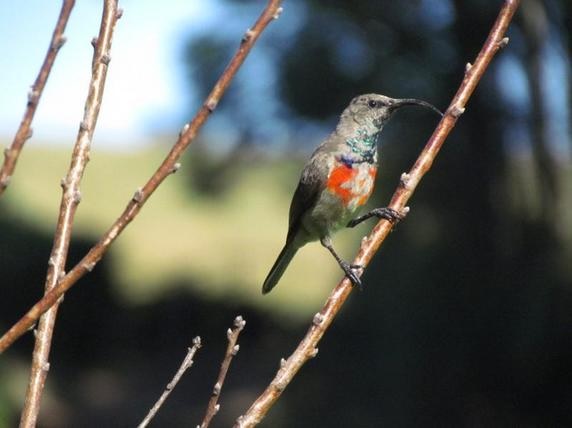
a female Malachite or Amythest Sunbird? (not sure)
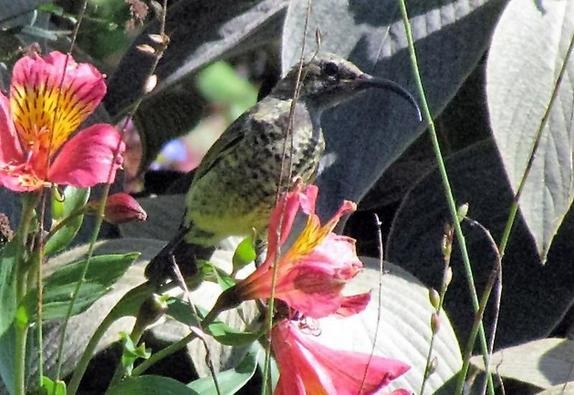
Male Malachite in eclipse

An arum lily frog was hiding amongst the pot plants for a couple of days during the cold weather.

Our skinks have disappeared now. Have a photo of the skin of one of them who was shedding his skin in our study. He was actually pulling off the skin of his legs with his mouth. He ran under the couch, hence only pic of body skin left on carpet.

Have not seen our Blue Crane for 6 weeks now but early one morning, beginning of may, woke to see 8 Grey Crowned Crane and 3 Wattled Crane at the dam. They flew off at sunrise.

The Wattled Crane swam around the dam for a while foraging with their long necks. The dam was quite shallow at this stage.

The Long-crested Eagle is still around

The African Harrier-Hawk (Gymnogene) arrives on the farm at about 07:30 on most days hopping around the rocks. With the lizards (skinks) which seem to have vanished around the house, he must be eating mice and rats.

Pat saw a pair of Oribi running through the farm. There are still a few Reedbuck and Duiker around.
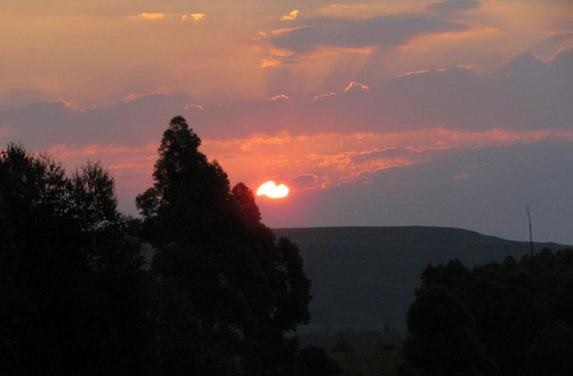
At about 10pm one night the dogs started barking, (in that special way when something is amiss) and we went out to find a huge porcupine around our pond area next to the stone wall. He was trying to hide behind a tree to get away from the dogs. We put the animals away and tried to shush the porcupine out the gate, but he was having none of it and proceeded to try and climb the stone wall. This ended with him falling down, and nearly on top of Pat. He raced off with speed and we could not find him after that. He must have come through the culvert as our whole garden has bonnox fencing to keep the animals from encountering our dogs and prevent them from destroying my garden.
Bokmakierie

Juvenile Amethyst Sunbird who now has his amethyst throat

Grey Crowned Cranes and African Spoonbills

Ashley Crookes – Copperleigh Farm
Sunset over the now very low Mavela Dam
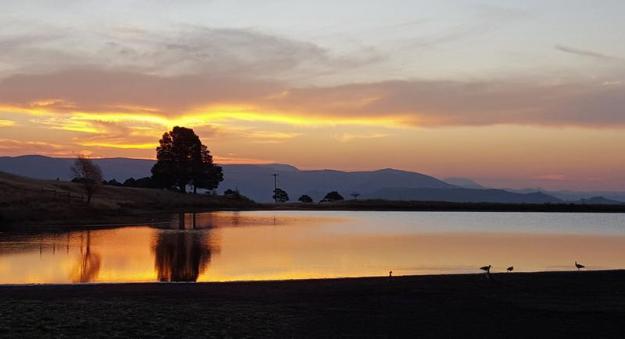
Nola, God’s Grace – I may have seen the same little frogs in my Howick home, also parcelled up neatly on the glass windows – and who jump amazing distances. I thought it may be an arum lily frog though darker in colour than the Cape Town ones? Or a leaf – folding frog? Delicately coloured with bright orange-red underparts on body and legs. Liz Gow lizgow@futurenet.co.za
LikeLike
The merry month of May! Fantastic colorful pictures. Than you for sharing.
LikeLike